About this book
Economic archaeology is the study of how past peoples exploited animals and plants, using as evidence the remains of those animals and plants. The animal side is usually termed zooarchaeology, the plant side archaeobotany. What distinguishes them from other studies of ancient animals and plants is that their ultimate aim is to find out about human behaviour – the animal and plant remains are a means to this end. The 33 papers present a wide array of topics covering many areas of archaeological interest. Aspects of method and theory, animal bone identification, human palaeopathology, prehistoric animal utilisation in South America, and the study of dog cemeteries are covered. The long-running controversy over the milking of animals and the use of dairy products by humans is discussed as is the ecological impact of hunting by farmers, with studies from Serbia and Syria. For Britain, coverage extends from Mesolithic Star Carr, via the origins of agriculture and the farmers of Lismore Fields, through considerations of the Neolithic and Bronze Age. Outside Britain, papers discuss Neolithic subsistence in Cyprus and Croatia, Iron Age society in Spain, Medieval and post-medieval animal utilisation in northern Russia, and the claimed finding of a modern red deer skeleton in Egypt's Eastern Desert. In exploring these themes, Economic Zooarchaeology celebrates the life and work of Tony Legge (zoo)archaeologist and teacher.
Contents
Introduction
Authors’ addresses
Tone Legge – a bibliography
Part 1: Bone Man: the career and influence of Tony Legge
1. Robin Dennell Tony Legge, 1939-2013
2. Harvey Sheldon (with a contribution by Nick Bateson, Mike Hacker and Geraldine Missig) Tony Legge and Continuing Education in Archaeology at the University of London 1974-2004
3. Andrew M. T. Moore “The lowing herd winds slowly o’er the lea…”: Tony Legge and the origins and spread of animal husbandry
4. Charles Higham Reflections on a dustbin: froth flotation and the origins of rice cultivation in southeast Asia
5. James F. O’Connell How the pig parts got from Warrago to Web
6. David Jacques Tony Legge and the Blick Mead Mesolithic Project
Part 2: Zooarchaeological method and theory
7. Anthony J. Legge Bone measurements and body weights from some Australian feral pigs
8. Anthony J. Legge and Chris Stimpson A morphometric investigation of late Pleistocene and Holocene humeri of aoudad (Barbary sheep: Ammotragus lervia, Pallas 1777) recovered from the Haua Fteah, Cyrenaica, Libya
9. Simon J. M. Davis Towards a metrical distinction between sheep and goat astragali
10. Tony Waldron Down among the dead men: wrong end epidemiology and its implications for palaeopathology
11. Angela Perri A typology of dog deposition in archaeological contexts
12. A. Sebastián Muñoz and Mariana Mondini The boundaries of the world: the archaeology of humans and animals in southern South America
13. Dale Serjeantson Zooarchaeology in Britain: a partial history
The zooarchaeology of milking controversy
14. Paul Halstead and Valasia Isaakidou Calf mortality and milking: was Tony Legge right after all?
15. Angelos Hadjikoumis Age-at-death in traditional Cypriot sheep and goat husbandry: implications for zooarchaeology
16. Rosalind Gillis A calf’s eye view of milk production: Tony Legge’s contribution to dairy husbandry studies
17. Pam J. Crabtree Rethinking dairying in the Irish Iron Age: evidence from Dún Ailinne
18. Alan K. Outram Answering zooarchaeological questions from the analysis of animal bones and organic pottery residues: a critical comparison
19. Peter Bogucki Salt, cows, milk, and the earliest farmers of Central Europe
Part 3: Farmers that hunt
20. Jonathan C. Driver and Shaw Badenhorst Hunting by farmers: ecological implications
21. Carlos Tornero, Marie Balasse, Joël Ughetto-Monfrin, Miquel Molist and Maria Saña Evaluating seasonality of birth in gazelles in the Middle Euphrates Valley: confirming ethological assumptions in the Abu Hureyra model
22. Haskel Greenfield Hunting and herding in the Middle Neolithic of central Serbia: a zooarchaeological analysis of Stragari-Šljivik, Serbia
Part 4: Prehistoric Britain
23. Peter Rowley-Conwy To the Upper Lake: Star Carr revisited – by birchbark canoe
24. Roger Mercer The first farmers in Britain and Ireland – whence, whither and how? Some reflections
25. Glynis Jones and Amy Bogaard Integration of cereal cultivation and animal husbandry in the British Neolithic: the evidence of charred plant remains from timber buildings at Lismore Fields
26. Richard Bradley Taphonomy and cultural selection: Tony Legge and the Neolithic pits beside the Dorset Cursus
27. Mark Maltby Humans and animals in Mesolithic, Neolithic and Bronze Age Dorset
28. Sonia O’Connor and Terry O’Connor Reconsideration of the ‘Mesolithic harpoon’ from Westward Ho!, Devon
Part 5: Continental Europe and the Mediterranean
29. Paul Croft Revisiting the animal remains from Neolithic Kalavasos Tenta, Cyprus
30. Suzanne E. Pilaar Birch Neolithic subsistence at Vela Špilja on the island of Lošinj, Croatia
31. Lidia Colominas Using faunal remains to evaluate social stratification in the Middle Iron Age: the fortified village of Mas Castellar de Pontós, northeast Iberian Peninsula
32. Alexei K. Kasparov The economy of Medieval and Post-Medieval Vyborg, Russia, in its historical context
33. Salima Ikram and Louise Bertini Dear, oh deer! The adventures of compiling comparative collections: a cervid skeleton allegedly from Egypt’s Eastern Desert
Customer Reviews
Biography
Peter Rowley-Conwy is professor of environmental archaeology at Durham University. He specialises in hunter-gatherers, early farmers, and the transition to agriculture. He has worked on Mesolithic and Neolithic animal bones in various parts of Europe including Denmark, Italy and Portugal, and the Middle East.
Dale Serjeantson is a Research Fellow at the University of Southampton. She was the Director of the Faunal Remains Unit and was one of the founders of the MA in Osteoarchaeology. As well as early farming in Britain her research interests include medieval food and its connotations and the interpretation of bird remains.
Paul Halstead is professor of archaeology at the University of Sheffield. He specialises in the archaeology (including zooarchaeology) of early farmers and early complex societies in Greece and the ethnoarchaeology of traditional farming and herding in Mediterranean Europe.



































